At a State House hearing before the Special Senate Task Force on Fisheries, Chris Brown of the Rhode Island Commercial Fisheries Association testified to the importance of protecting the state’s ports from incompatible condo and hotel development. From the Providence Journal:
Chris Brown, president of the Rhode Island Commercial Fisheries Association, said the New England groundfish industry has declined from 1,200 vessels to about 477 in 30 years. But with all the cutbacks in fishing effort, he now expects big increases in fish stocks and catches.
He called on the committee to make sure no port areas are converted to condominiums or hotels, because the state is going to need more space to serve the fishing industry as it’s reborn.
 State Senator and port study commission co-chair William Walaska recently addressed the Providence Propeller Club and talked about the importance of protecting and expanding Rhode Island’s port and water-dependent businesses:
State Senator and port study commission co-chair William Walaska recently addressed the Providence Propeller Club and talked about the importance of protecting and expanding Rhode Island’s port and water-dependent businesses:
During hearings of the commission and as a result of tours of port facilities around the state, Senator Walaska told the Propeller Club gathering in East Providence, “members became better educated about the opportunities and challenges faced in the maritime industry (and are) very supportive of not only maintaining existing port activities but also identifying ways to expand and provide new opportunities for water dependent businesses to relocate to Rhode Island’s waterfront and grow our maritime jobs base.”
Senator Walaska told the organization that the commission, which issued an interim report earlier this year, is planning more hearings in the coming months. Among the areas that will be under study, he said, are a strategic plan for the state’s port facilities; a review of channel maintenance dredging requirements and considerations; development of a Marine Highway System hub in Rhode Island in partnership with the U.S. Department of Transportation, and coordination of state efforts to expand maritime commerce with municipal land use regulations.
“It is critical during these difficult economic times for Rhode Island to work in partnership with port managers and water dependent business owners,” he said. “These partnerships should promote all of Rhode Island’s waterfront assets in a way that will increase job opportunities for the thousands of Rhode Islanders now unemployed or underemployed.”
“The Ocean State’s history is deeply rooted to the working waterfronts of the state and I expect the work of the commission will continue this tradition for the benefit of the state’s residents and businesses,” he said.
Rhode Island Sea Grant has just finished an important study which inventories all of the state’s commercial/industrial ports and harbors. The report notes that Rhode Island, the Ocean State, is running out of waterfront property suitable for water-dependent commercial uses:
The processes of creating the GIS‐based Inventory and forming a supportive network of public and private partners have contributed to initiating a rich dialogue amongst government, private sector, and community interests. This is now helping Rhode Island examine how urban waterfronts can be better embraced as tools for important state goals such as the creation of quality jobs, reliance on a mix of traditional and renewable energy resources, and development of a more efficient, effective and secure marine transportation system. All of these goals are illustrative of pressing economic, social, and environmental issues now facing Rhode Island and the New England region.
Within this context – fostering marine‐based industry as one means of solving key problems – the GIS‐based Inventory points to a critical challenge: land appropriate for coastal commercial use, or acreage with adjacent Type 6 waters, is extremely scarce. Timely implementation of balanced planning approaches is sorely needed to integrate and make best use of the remaining parcels’ full array of economic, social, and environmental assets.
— Page 37, Rhode Island Ports & Commercial Harbors report
As reported in the Providence Journal, the three major Providence mayoral candidates — Steven Costantino, John Lombardi, and Angel Taveras — all oppose plans to rezone Allens Avenue to allow for incompatible non-industrial uses.
And all are opposed to Mayor Cicilline’s proposed rezoning of the industrial South Providence waterfront, which would allow bars, restaurants, hotels and other non-industrial uses.
– Primary for Providence mayor is tough to call, Sunday, September 5, 2010
Democratic mayoral candidate Rep. Steven M. Costantino said last week that he is opposed to Mayor David N. Cicilline’s plan to rezone the industrial South Providence waterfront to allow for bars, restaurants, hotels and other non-industrial uses . . .
Fellow Democratic mayoral candidates City Councilman John J. Lombardi and Angel Taveras, a former Housing Court judge appointed by Cicilline, have also stated their opposition to the mayor’s proposed rezoning plan.
– Costantino opposes waterfront rezoning plan, Monday, September 6, 2010
Mayoral Candidate Statements On Allens Ave’s Working Waterfront
Steven Costantino
Costantino will work with business to develop jobs along a working waterfront
Jobs speech:
And our waterfront is flush with opportunity for sustainable jobs. There is no doubt that a working waterfront is part of the comprehensive and smart plan for this city’s economic development.
John Lombardi
2007 comments and vote against comprehensive plan with Allens Ave waterfront changes:
Some council members have argued that the city doesn’t need to submit the plan in stages at all, and can wait for the neighborhood planning process to conclude. Councilman John J. Lombardi said last night that the city does not need to rush things, as the current plan should still function legally and govern local development even though it has expired.
“To go forward as we are, it may just be unwarranted and inappropriate,” Lombardi said.
Source: http://www.projo.com/ri/providence/content/MC_PLAN_10-16-07_577GEAE.30b7e9d.html
The plan was passed 10 to 3, with several council members saying that they did not see the need to pass the plan now, and urging their colleagues to wait until the charettes are completed.
“Now is not the time to turn our backs on our neighborhood. Let our citizens be heard,” said Councilman Kevin Jackson, who was joined by Josephine DiRuzzo and John J. Lombardi in opposition.
Source: http://www.projo.com/ri/providence/content/MC_COUNCIL_11-02-07_MK7NEM4_v9.3148874.html
Angel Taveras
Protect Providence’s Working Waterfront from development that could endanger the industrial productivity of the Port of Providence.
Source: http://angelforprovidence.com/en/issues/jobs-a-economy.html
Jobs & Economic Development speech:
(6) I will protect jobs at the Working Waterfront – an invaluable economic asset for our city – from development decisions that would endanger the industrial productivity of the Port of Providence.
Notes opposition to mixed-use zoning in 10 News Conference interview (at 20:45)

Projo.com has an excellent “R.I.’s future maritime jobs” piece by marine experts Peter Michaelson William Coffey, and George Shuster Jr. The article notes the tremendous potential for marine industrial growth in Rhode Island, including at the Port of Providence, which the authors argue must be protected from incompatible uses:
The Port of Providence is an example of an intermodal facility already in service for many years. It stands as the best example of commercial/industrial port activity in the state. Adjoining businesses include ProMet Marine, one of the two remaining active, full-service commercial shipyards in Rhode Island (the other is the Blount Shipyard, in Warren). ProMet serves the shipping and fishing industries with high-tonnage facilities for repair and maintenance of vessels. A number of other port-dependent businesses also adjoin the facility, including tanker off-loading docks, fuel-tank farms and truck distribution facilities, a tug and barge base, and others.
However, expansion of maritime industry at the Port of Providence is limited by a number of factors.
First, although acreage available is adequate for present tenants and enterprises and space remains for a limited amount of further development, intensive development will be limited by available space.
Second, while the happy coincidence of a complex shoreline to the south of the Port has enabled development of the former Fields Point shipyard as a Johnson & Wales University center, together with the new Save the Bay education and research center, this juxtaposition of uses will not work as easily to the north or directly to the west of the Port. Non-industrial redevelopment of Conley’s Wharf and adjacent property is thus not appropriate; another use for that site should be sought. Appropriate uses might include fabrication of wind turbines, or development of a cruise-ship terminal.
Future development of the Port of Providence, together with the proposed “Knowledge District,” badly needs a buffer zone between them. One desirable way to integrate a buffer zone with current proposals would be to establish a green strip where light rail cars would connect the port, knowledge sector enterprises, human services and residential areas of the city.
State Senator William Walaska has a strong letter to the editor in the Warwick Beacon which argues for the need to protect Providence’s water-dependent port businesses from incompatible mixed uses:
Keeping commerce at the Port of Providence
To the Editor:
As Co-Chair of the Joint Legislative Port Commission, I want to offer my statewide perspective on waterfront development and redevelopment, especially as it relates to the ordinance amendments before the Providence Ordinance Committee. My statewide perspective has been developed during the past year and a half of meetings and tours conducted by the legislative Port Commission that included the waterfront of Providence and ProvPort. While I appreciate the city’s vision for a vibrant and mixed use waterfront zone, I am concerned that some of the permitted uses within these zones may conflict with the region’s energy infrastructure as well as existing businesses located in the area to be re-zoned.
The legislative Port Commission has heard extensive testimony regarding the limited amount of property still available for development or redevelopment of water-dependent businesses. In fact a recent study conducted by the URI Coastal Resources Center and Rhode Island Sea Grant found that there are as little as four parcels statewide totaling 41 acres that are available for development in areas that have Type 6 waters, which are permitted for commercial and industrial water dependent uses. Providence is host to some of the most important infrastructure in the region that supplies critical energy resources to hundreds of thousands of homes and businesses. In addition, many existing businesses along Allens Avenue have expressed serious concerns about how new permitted uses within the proposed zones could negatively impact their ability to operate as often and as late as is sometimes required by their business.
The decisions the City Ordinance Committee members make will have a long-lasting impact on the state’s and the region’s ability to compete in the marketplace for industrial and commercial enterprises that rely on access to deepwater channels. I caution the Committee to carefully consider the potential zoning changes that are proposed and how those changes may change the landscape of the working waterfront for generations to come. It is critical that Providence continues to provide the vital services to the state and the region that its residents and businesses rely on and not jeopardize the ability of those services to be delivered in a timely and cost-effective manner. As the Department of Energy noted in its letter to Governor Carcieri dated Nov. 10, 2009, “Rezoning may result in future restrictions on terminal operations to accommodate residential preferences that could endanger the economic viability of the terminals given the differing nature of the established and proposed uses of the areas in question. This could eventually result in the loss of petroleum storage capacity for the region.”
I appreciate the city’s continued communication with the legislative Port Commission on these and other important issues. I will continue to provide leadership for port-related activities and encourage decision-makers to not only maintain current water-dependent uses but expand these uses wherever possible statewide.
Senator William A. Walaska
Warwick
June 9th pictures from a busy Promet Marine shipyard bustling with repairs to a Coast Guard cutter and several commercial fishing vessels.
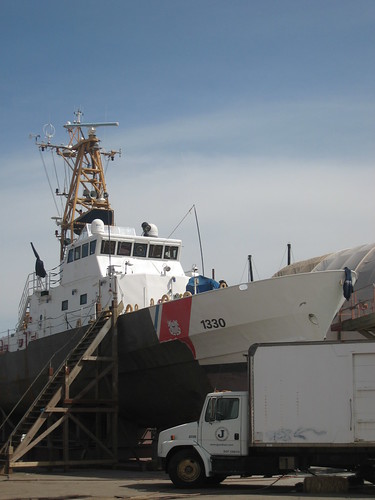



At a recent presentation to the members of the Newport County Chamber of Commerce, Rhode Island Economic Development Director Keith Stokes noted the importance of investing in our state’s shipyards and ensuring that local zoning supports these businesses. As reported in the Spring 2010 edition of the Newport County Chamber’s Business Journal:
Over recent decades, much of the commercial shipbuilding and other marine trade activity has been lost in Rhode Island. To grow the Ocean State’s marine industry, Stokes advocates that we invest in the remaining three large shipyards in Providence Harbor, Quonset Bay and Portsmouth’s Melville area where mega – yachts are currently fitted out and serviced. We also need to ensure local zoning continues to support this type of business activity. Stokes advocated for Quonset’s port utilization as a Short Sea Destination. Large container ships can offload in Newark, New York, or Boston. Trains and/or small container ships would bring goods to Rhode Island port saving shippers significantly versus using traditional 18-wheeler trucking.
Today’s Providence Journal has an opinion editorial by Providence Working Waterfront Alliance founding members Sprague Energy, Promet Marine, and Narragansett Improvement about the city’s failed mixed-use vision for Allens Ave:
In June 2000, then-Mayor Vincent Cianci Jr. held an event to unveil his grand “New Cities” urban renewal plan for future development in Providence. Rolled out to great fanfare, the plan envisioned a new “Narragansett Landing” neighborhood along Allens Avenue’s historically industrial harbor front. The plan included beautiful drawings of waterfront promenades, residences, hotels, and marinas. Completely absent however, was any depiction of the area’s existing oil tanks, barges, cargo tankers or industrial businesses.
Indeed, these industrial businesses were explicitly not part of the plan and were to be wiped off of the face of the waterfront. As The Journal reported at the time, “he [Mayor Cianci] . . . said he hopes to sweep away a boatyard, an asphalt plant, oil and gas storage tanks and industrial docks to make room for hundreds of apartments with their own boat slips, 3 hotels, 12 office buildings, and a 40-acre marina with space for 500 boats.”
Ironically, almost 10 years after the unveiling of the Narragansett Landing plan, it is the city’s mixed-use vision that has failed, not the gritty industrial businesses located along Allens Avenue’s working waterfront in the Port of Providence. The area’s only announced mixed-use project, the proposed $300 million Providence Piers condo, hotel, and marina development, is now in foreclosure and the subject of ongoing litigation.
In stark contrast, despite facing the threat of condemnation, eminent domain, and being zoned out of existence, the area’s water-dependent and industrial businesses are not only still stubbornly on the avenue, they are thriving. According to the June 2008 economic impact study, just seven water-dependent, water-enhanced industrial businesses along Allens Avenue are responsible for $294 million in annual business sales, employ 372 workers with an average compensation of approximately $60,000 per year, and have a total annual economic impact of $324 million.
With a 40-foot, federally dredged channel, a strategic location between Boston and New York City, and excellent rail and highway access, the Allens Avenue corridor is poised for continued success. With the proper zoning in place and a commitment to promote this unique industrial asset, Providence’s working waterfront is sure to grow and create new good paying jobs.
Hotels can be built anywhere. We need a waterfront that works.
In a 10 News Conference interview, Providence mayoral candidate Angel Taveras notes his opposition to mixed-use zoning for Allens Avenue’s working waterfront. Instead, Taveras argues the city should promote Providence’s unique port assets and give existing industrial businesses the confidence needed to expand and create new jobs. Watch the interview here – working waterfront comments at 20:45.

This week’s Providence Business News has an excellent article about the good blue collar jobs provided by the many industrial businesses along Allens Avenue’s working waterfront in the Port of Providence, and why these jobs are threatened by incompatible mixed-use zoning:
This year marks Chris Beauchamp’s 32nd anniversary working for Narragansett Improvement Co. on Allens Avenue in Providence. During his three-decade career, Beauchamp married, bought a house, raised two children and rose to superintendent with an annual pay close to $100,000. But Beauchamp worries that his job could be gone and his bills will remain if the city proceeds on a path to rezone the area and allow new uses. . .
Local businesses say the area already is an important economic driver for the state. Based on information provided by the business group the Providence Working Waterfront Alliance and Providence Business News research, the approximately 37 businesses along the one-mile strip of road employ more than 2,150 people, including 953 workers at the associated companies that comprise the city-owned Port of Providence.
Other large employers include the adult-entertainment industry, which employs more than 250 workers, and the Narragansett Bay Commission, which employs 200 people at the sewage-treatment plant. The five businesses north of the waterfront protection zone that are completely water dependent employ 112 people.
Narragansett Improvement Co. employs about 70 people during the height of the construction season.
“My livelihood obviously is Narragansett Improvement,” Beauchamp, 50, said. “If they’re telling us we have to move our asphalt plant, who’s going to take us?”
Down the street, Paul Baker, general manager at Promet Marine Services Corp., said his job supports countless others in the area. The ship-repair company sends electrical components for repair to Walco two blocks away. Then for lunch, Baker and his co-workers frequent the Seaplane Diner a few hundred feet away.
“It’s all interrelated,” Baker said.
Yesterday, Grow Smart Rhode Island held a port development forum to discuss ways to manage and grow our state’s ports and working waterfronts. Watch this NBC 10 segment detailing the state’s interest in growing working waterfront jobs, yet the City of Providence’s reluctance to encourage marine industrial growth on Allens Ave in the Port of Providence.
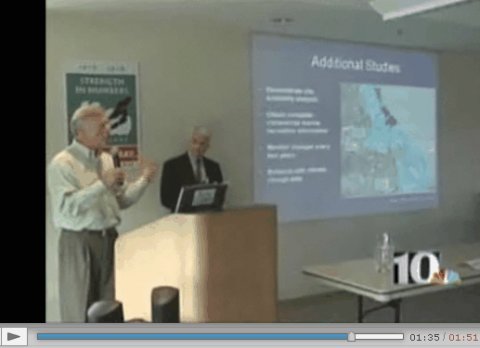
Rhode Island Recycled Metals is a new water-dependent marine industrial business on Allens Ave in the Port of Providence. Watch NBC 10’s R.J. Heim describe how the company is scrapping the former Russian cruise missile attack submarine, the Juliett 484.

Friday, April 2nd was a beautiful sunny day on the Allens Avenue working waterfront in the Port of Providence. Below are a few pictures from a busy yard at Promet Marine.
The Lady Frances from Point Judith being hoisted out of the water for repairs by Promet’s 400 metric ton marine travelift.

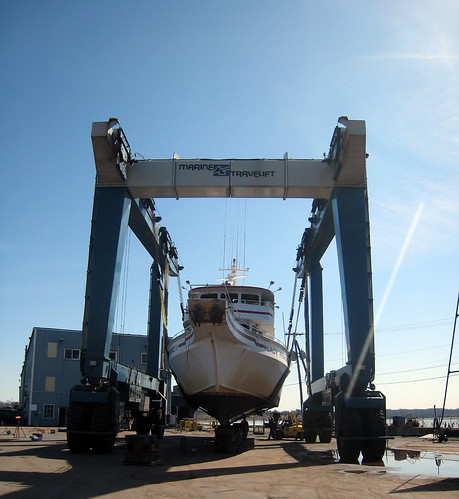
Fishing vessels in for repair.
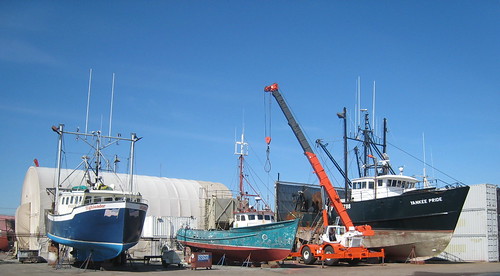
Today’s Providence Journal has an excellent article on just how much commercial shipping traffic there is Narragansett Bay, and how important this working waterfront activity is to Rhode Island and the region.
Rhode Island’s coastal waters are “an important and highly valuable marine transportation corridor,” the report says, for such vessels as “tankers, bulk carriers, and tug and barges; passenger ferries; naval vessels; government research; enforcement and search-and-rescue vessels; and pilot boats.”
The report documents thousands of transits in and out of Narragansett Bay each year by commercial shipping.
Using 2007 data from the U.S. Army Corps of Engineers, the report noted the following:
• 178 dry cargo vessels visited Providence and 145 went to Fall River.
• 233 tankers visited Providence and 6 went to Fall River.
• 403 tugs visited Providence and 388 went to Fall River.
• 948 barges visited Providence and 111 went to Fall River.
Those 2,412 transits don’t include an additional 160 to 200 transits made by ships to Quonset that the Army Corps does not count . . .
The report said a study done for the Providence River dredging project found that marine transportation industries, along with recreational and fishing related industries, generated $586 million in direct economic impact on the state’s budget in 2000 as well as 12,265 jobs.
This level of economic impact demonstrates why it makes no sense to waste Providence’s Allens Avenue working waterfront — with it’s strategic location on a 40ft federal deep water channel and highway and rail access — on glitzy condos and hotels that can be built anywhere. Unlike condos and hotels, water-dependent marine industrial businesses must have access to the water and that’s why Rhode Island needs to protect and preserve it’s critical working waterfronts.
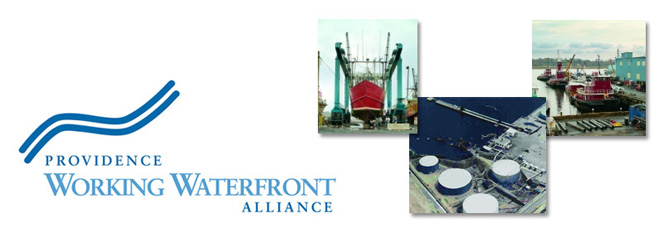
 State Senator and port study commission co-chair William Walaska recently addressed the Providence Propeller Club and
State Senator and port study commission co-chair William Walaska recently addressed the Providence Propeller Club and 









